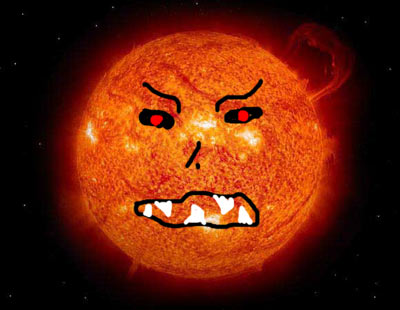‘
Since forever, people have tried to tie events on Earth to either the phases of the Moon or the solar sunspot cycle.
Some things do correlate, of course. Tides depend on the Moon, and some animals have their breeding cycle tied to the full Moon. Solar storms depend on the sunspot cycle; or, more accurately, the magnetic field of the Sun fluctuates on an 11 year cycle, and several other solar characteristics are wrapped up in that, including sunspots.
But some take it too far. You’ve probably heard that people act crazy during a full Moon, that there are more violent crimes, babies born, ER visits during the full Moon– ask any nurse. But this has been studied extensively, and it has been shown beyond a shadow of a doubt that in fact there is no rise in such things during a full Moon, or any other phase. It’s a selection effect– a bias in our judgement, when we remember some interesting things and forget mundane ones. If someone says more crimes happen during the full Moon, and you see an ax murder during the full Moon, then in your mind the conclusion is confirmed. But you forget all the other ax murders you saw during other phases of the Moon.
Assuming, of course, you see a lot of ax murders.
Anyway, whenever something happens in any kind of cycle, people either blame the Moon or sunspots. And now, ABC News is reporting a finding that strokes may be tied to solar flares. A Slovak doctor, Michal Kovac, found that strokes in the town of Nove Zamky rose during the time in 2000/2001 when solar activity was at a peak. Given that solar storms profoundly affect the Earth’s magnetic field, and our bodies use electricity to function, then is he on to something? As the article notes:
Despite skepticism from astronomers, Kovac and colleagues in the U.S. and Japan think fluctuations in the earth’s magnetic field caused by the ejections may disturb the electro-chemical reactions that make human bodies work.
Hey, I’m an astronomer and a skeptic. I am indeed a skeptical astronomer. For one thing, the effect on the Earth’s magnetic field happens pretty far away from the surface. It takes a pretty big hit from the Sun to affect us here on the surface (though that has happened– a big solar storm, called a coronal mass ejection, blew out power in Quebec in 1989). For another, it’s not at all clear that humans and our big pattern-finding brains are affected by the Earth’s magnetic field.
Kovac, though, says there is a history to this:
Kovac says his work, recently published in the Bratislava Medical Journal, builds on studies that show parts of the human body respond to fluctuations in the earth’s geomagnetic field caused by sun storms.
I have not heard of these studies, nor can I find this recent study online, unfortunately. I’d love to read them– if anyone out there in astroblogland can get their hands on them, please let me know. The news article says nothing about scientific tests, or statistical checks to make sure the study’s findings are robust. Was the study in Nove Zamky long-term, long enough to correlate it strongly to sunspots? Are people in Nova Zamky prone to more or fewer strokes than the average populace? Is there something else that could be causing it – like, do people in Nove Zamky have elections every 5 years, resulting in raised blood pressure?.
OK, that last one may be a bit silly but the point I’m making is that there are lots of things that affect the human body, and looking toward the Sun may be a bit of a stretch. Scientists are supposed to be skeptical, and so until I can see better data, I’m putting this one firmly in the “wait and see” category.’